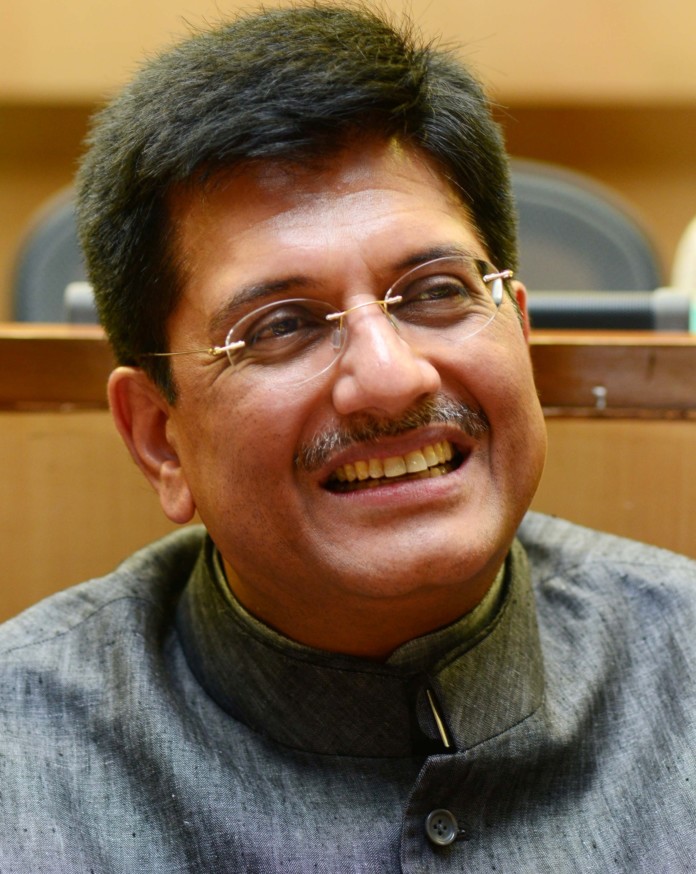India has been doing well with meeting its aggressive target on generating renewable energy. But the big question is – will it continue to import everything – from solar panels, storage batteries, wind turbines and blades? This will not only apply enormous strain on foreign exchange, it is akin to forsaking massive potential to make them locally – which will help employment and investment. There are no strong signs of a solar energy product manufacturing although some talk about it takes place in public forum. Edited excerpts of talk by Piyush Goyal, Minister of State for Power, Coal, New and Renewable Energy and Mines, at an energy conference in Abu Dhabi recently
Although India remains dependent on coal to fuel its energy needs, it aims to scale up its solar power capacity to 100GW by 2022. It is targeting 60GW from wind energy and plans to bring in hydro power, from which it generates 40GW, into the category of renewable energy. By 2022, the country plans to generate around 225GW from clean and renewable sources. When other global industry experts said renewable energy needs private funding to be successful, Goyal said he does not see any challenge in getting finance for renewable energy in India.
“Gone are the days when government had to bring in subsidies. We don’t need to convince the industry anymore. We just need to make sure that there are no roadblocks. The 100 gigawatt target for solar should not be a constraint. India won’t stop at 100 GW,” Goyal said.
“We can manufacture at scale. A subsidy regime is not the best way to move forward. We need to draw up a regime where government can be an enabler for manufacturing to compete at good quality and prices,” Goyal said.
We need to foster partnerships with high quality technology suppliers. We will provide large tracts of land to manufacture at scale. Indian developers should also promote Indian manufacturing.”
India has positioned itself as a leader in the renewable energy space by spearheading the creation of the International Solar Alliance (ISA). ISA, through the principle of demand aggregation, could potentially lead to significant further decline in solar technology costs, as multiple countries come together for scaling global solar power production. This is what India did domestically with the hugely successful LED procurement and distribution program.
It is only through market interventions like these that the costs of mitigation technologies could be lowered globally, making mitigation actions relatively easier, as well as lowering the need for supporting finance.
The minster was of the view that India should manufacture in India for India and should assess what it would take for the country to be an end-to-end solution provider for solar energy.
India has been doing well with meeting its aggressive target on generating renewable energy. But the big question is – will it continue to import everything – from solar panels, storage batteries, wind turbines and blades? This will not only apply enormous strain on foreign exchange, it is akin to forsaking massive potential to make them locally – which will help employment and investment. There are no strong signs of a solar energy product manufacturing although some talk about it takes place in public forum. Edited excerpts of talk by Piyush Goyal, Minister of State for Power, Coal, New and Renewable Energy and Mines, at an energy conference in Abu Dhabi recently
| A |
lthough India remains dependent on coal to fuel its energy needs, it aims to scale up its solar power capacity to 100GW by 2022. It is targeting 60GW from wind energy and plans to bring in hydro power, from which it generates 40GW, into the category of renewable energy. By 2022, the country plans to generate around 225GW from clean and renewable sources. When other global industry experts said renewable energy needs private funding to be successful, Goyal said he does not see any challenge in getting finance for renewable energy in India.
“Gone are the days when government had to bring in subsidies. We don’t need to convince the industry anymore. We just need to make sure that there are no roadblocks. The 100 gigawatt target for solar should not be a constraint. India won’t stop at 100 GW,” Goyal said.
“We can manufacture at scale. A subsidy regime is not the best way to move forward. We need to draw up a regime where government can be an enabler for manufacturing to compete at good quality and prices,” Goyal said.
We need to foster partnerships with high quality technology suppliers. We will provide large tracts of land to manufacture at scale. Indian developers should also promote Indian manufacturing.”
India has positioned itself as a leader in the renewable energy space by spearheading the creation of the International Solar Alliance (ISA). ISA, through the principle of demand aggregation, could potentially lead to significant further decline in solar technology costs, as multiple countries come together for scaling global solar power production. This is what India did domestically with the hugely successful LED procurement and distribution program.
It is only through market interventions like these that the costs of mitigation technologies could be lowered globally, making mitigation actions relatively easier, as well as lowering the need for supporting finance.
The minster was of the view that India should manufacture in India for India and should assess what it would take for the country to be an end-to-end solution provider for solar energy.











Sir we are travelling regularly by intercity Banda to Surat. There use to be two Its class compartment. Last few months one compartment was shifted to ions class. Now its class compartment removed and ions class one copatment is coming. Please help us as their are lot of travellers with its class monthly pass